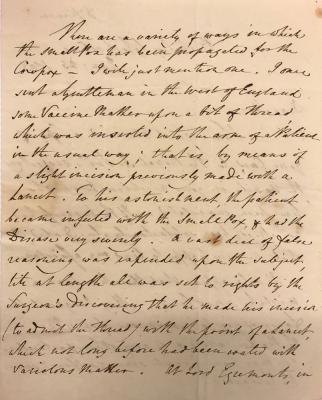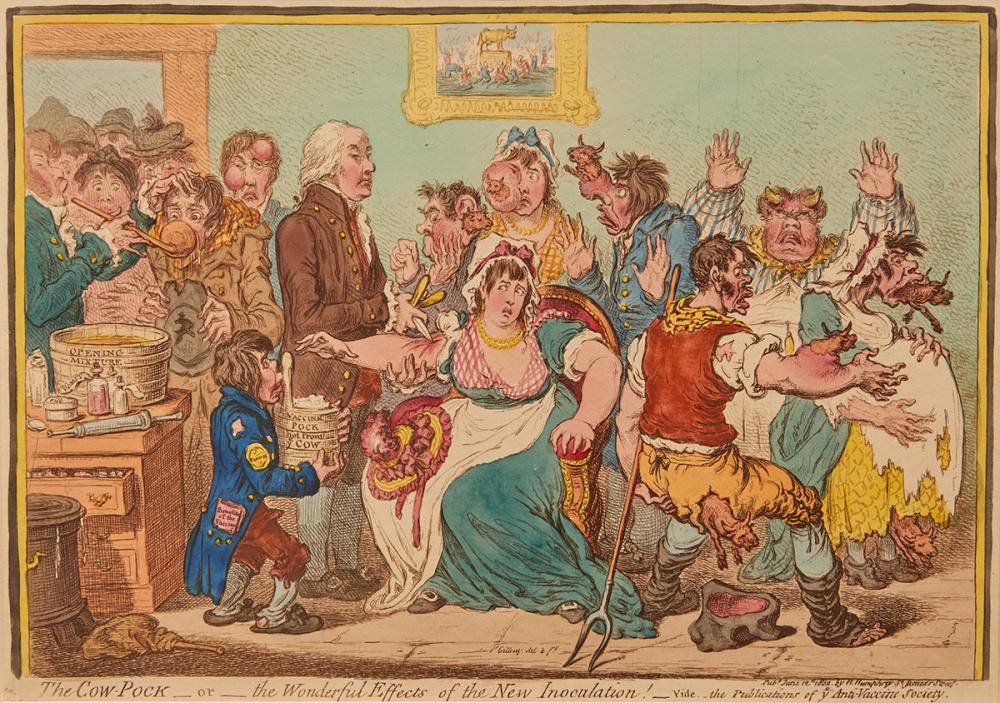This 1802 cartoon by English caricaturist James Gillray (1756–1815) is a striking reminder that the controversy surrounding vaccination is as old as the earliest days of the procedure itself. The print, which was bequeathed to the Morgan Library & Museum in 1986 by the collector Gordon N. Ray (1915–1986), was issued only four years after English physician Edward Jenner (1749–1823) privately published his landmark An Inquiry into the Causes and Effects of the Variolae Vaccinae : A Disease Discovered in Some of the Western Counties of England, Particularly Gloucestershire and Known by the Name of the Cow Pox. Jenner’s modest booklet summarizes his success in imparting immunity to the deadly disease of smallpox by inoculating patients with cowpox, a relatively benign virus of cattle and other livestock. The discovery would pave the way for the prevention of a disease responsible for an estimated 400,000 deaths per year in Europe alone during the eighteenth century. Where the smallpox was endemic, as it was in Jenner’s England, it was a perennial killer, particularly of children. In regions previously unexposed to the virus, such as Oceania and the Americas, it was the cause of historically catastrophic epidemics, devastating human populations on a scale that is difficult if not impossible to calculate to this day. By relying upon a similar but far less virulent infection associated with an animal host, Jenner’s vaccine held a key advantage over the previous and dangerously unpredictable practice of variolation, a technique which conferred immunity to the disease through inoculation with a mild strain of the smallpox virus. Jenner dignified cowpox in print with a name derived from the Latinate term “variola” (smallpox) and “vacca” (cow). His tribute to the source of his discovery lives on in our modern usage of the words vaccine and vaccination.
As Gillray’s cartoon suggests, opposition to Jenner’s vaccine was quick to emerge, with its bovine origins often provoking some of the most vehement criticism. Objections were made on both medical and religious grounds, condemning vaccination as a dangerous and unsanitary procedure involving the forbidden mingling of animal matter with human flesh. Outspoken opponents such as the physician Benjamin Moseley (1742–1819) sought to alarm readers with luridly worded arguments against the abominable practice of introducing a “bestial humour into the human frame,” while hinting darkly at the “strange mutations from quadruped sympathy”1 that might result as well as relating fantastical accounts of vaccinated children sprouting cow hair or developing facial features distorted “to resemble that of an Ox.”2
With his inventive flair for the grotesque, Gillray clearly recognized in the vaccine controversy an excellent opportunity to exercise his comic gifts as a visual artist. The result was a cartoon that succeeded in both ridiculing the credulity and absurdity of the most extreme anti-vaccination polemics and effectively illustrating the innate anxiety and even revulsion inspired by the debate. The setting has been identified as London’s Smallpox and Inoculation Hospital at St. Pancras. A figure probably intended to represent Jenner himself is shown presiding over the scene as he makes an incision in the arm of a young woman who shrinks away in fear as he prepares to inoculate the small wound with infectious lymph from a bucket labeled “Vaccine Pock hot from ye Cow.” A picture depicting the worship of the golden calf adorns the wall behind them. The doctor appears blandly indifferent to the plight of the newly vaccinated, who panic as miniature cows burst forth from their bodies and one unfortunate man sprouts a pair of horns.

Letter from Edward Jenner to Sir George Beaumont, 23 January 1804 (MA 2805). Gift of Julia Wightman, 1971.
Gillray’s tongue-in-cheek allusion to “ye Anti-Vaccine Society” should be taken with a grain of salt. Organized public opposition in the form of anti-vaccination societies didn’t spring up in England and America until after the introduction of legislation during the mid-nineteenth century that made vaccination compulsory. In fact, the years that followed Jenner’s discovery witnessed a growing demand for the vaccine that sometimes outstripped availability. As they strove to counter arguments and rumors purported to prove that the procedure was useless or unsafe, supporters in England and abroad made steady progress in their efforts to promote vaccination and educate both the public and the medical profession. In a letter from the Morgan’s collection written by Edward Jenner, dated January 23, 1804, and addressed to the prominent English art patron Sir George Howland Beaumont (1753–1827), the writer answers allegations attributing cases of smallpox to vaccination with cowpox. Jenner refers to some unfortunate cases in which patients were accidentally infected with smallpox through the administration of the cowpox vaccine with a contaminated needle. The letter serves to illustrate the challenges faced by Jenner and his contemporaries in their efforts to promote vaccination before medical practitioners understood the germ theory of disease or subscribed to modern concepts of hygiene.
Over the course of the nineteenth century, resistance to vaccination fluctuated in response to recurring outbreaks of the disease, political conditions, and efforts to temper the most provocative laws aimed at encouraging compliance. At the same time, successes and setbacks were coupled with steady improvements in the efficacy, availability, administration, and safety of the vaccine itself. Smallpox is estimated to have caused over 300 million deaths over the course of the twentieth century, before organized global efforts to eliminate the disease through mass vaccination succeeded in eradicating the virus worldwide. The last recorded outbreak of smallpox occurred in 1978 as a result of accidental transmission at a research laboratory in Great Britain. In 1980, the World Health Assembly officially declared the world free of naturally occurring smallpox, making it the first and only infectious human disease to be annihilated through the intervention of medical science.
Sandra Carpenter
Gordon Ray Cataloger
The Morgan Library & Museum
Endnotes
- Benjamin Moseley, A Treatise on Sugar. With Miscellaneous Medical Observations. (London: Printed by John Nichols, 1800) 183.
- Benjamin Moseley, An Oliver for a Rowland; or, A Cow Pox Epistle to the Reverend Rowland Hill. (London: Longman, Hurst, Rees, and Orme, 1807) 17.

